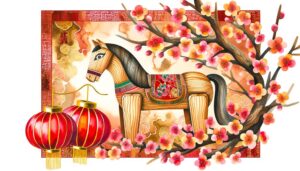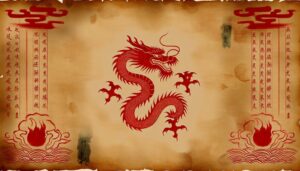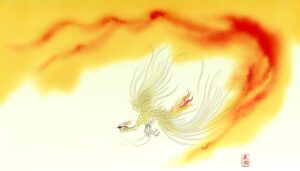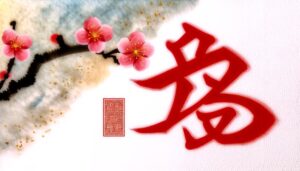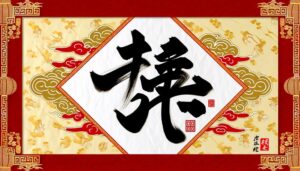What Does the Chinese Symbol on a Pug Forehead Mean?
Pugs often exhibit a distinctive forehead marking resembling the Chinese character for 'prince' (王), historically tying them to Chinese royalty. This symbol, lauded for its aesthetic appeal, signifies nobility, good fortune, and protective qualities.
Bred by Chinese emperors, pugs were highly valued for their companionship and loyalty. The clarity and appearance of the symbol may vary due to differences in fur texture and density.
Modern appreciation of these markings reflects a blend of ancient cultural symbolism and contemporary aesthetics. To uncover the intriguing interplay between pug heritage and symbolism, explore how these traits have evolved and endured.
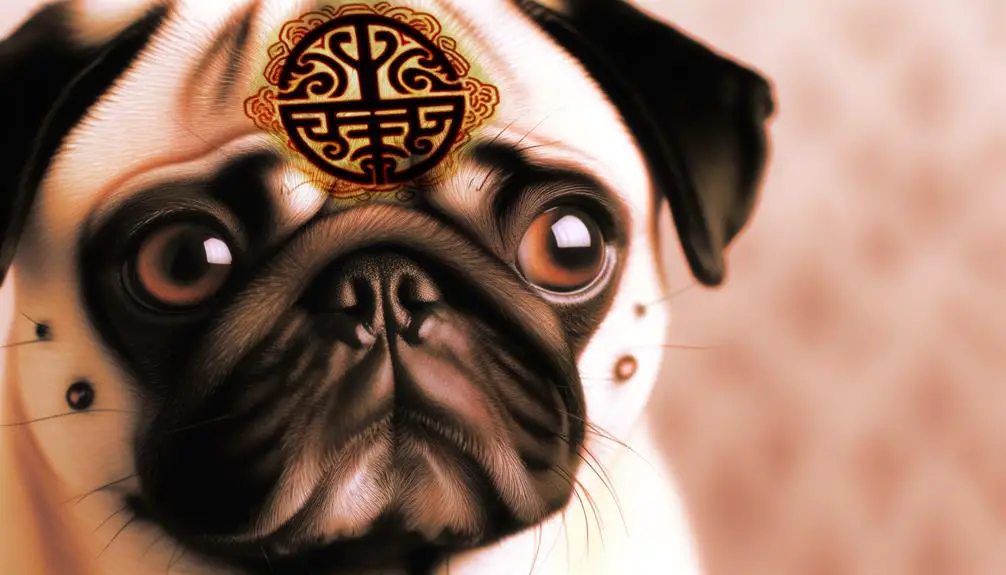
Key Takeaways
- Pugs have distinctive forehead markings resembling the Chinese character for 'prince' (王).
- These markings are linked to the breed's historical association with Chinese royalty.
- The symbol is believed to denote nobility, good fortune, and loyalty.
- Variations in shape, clarity, and symmetry occur among individual pugs.
- Modern appreciation of this marking influences fashion and cultural trends.
Historical Background
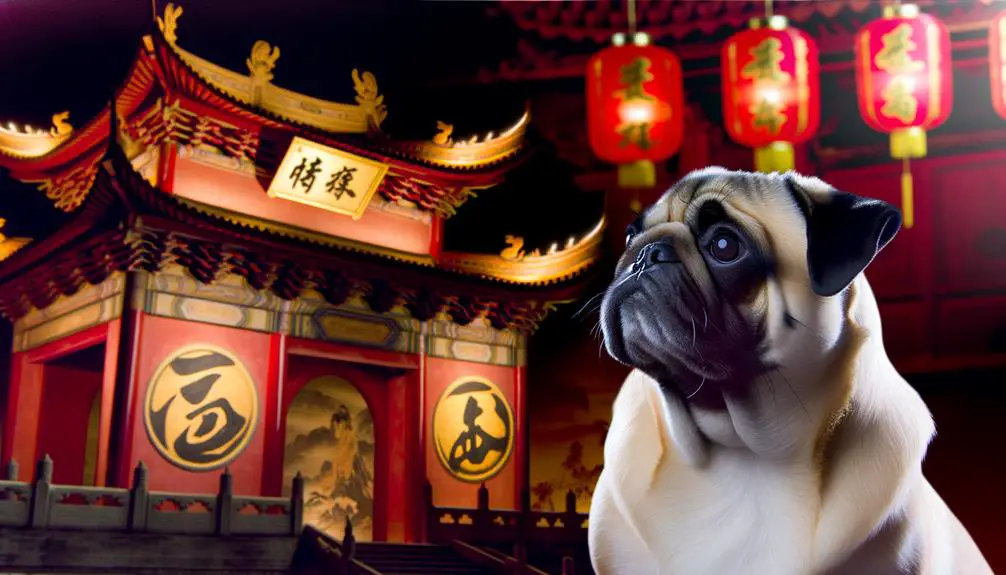
The distinct forehead marking that resembles a Chinese character on pugs has historical roots tracing back to ancient China, where these dogs were highly prized. These markings, often likened to the character for 'prince' (王), were considered a sign of nobility.
Pugs, known as 'Lo-sze,' were selectively bred by Chinese royalty to enhance this unique trait. The breed's lineage can be traced to the Han Dynasty (206 BCE–220 CE), where they were cherished as companion animals. Historical records indicate that pugs were kept by emperors and nobility, reflecting their esteemed status.
The deliberate breeding to emphasize specific physical traits highlights the importance of pug markings in ancient Chinese society, signifying their high cultural and social value.
Ancient Chinese Symbolism
Ancient Chinese symbolism imbued objects, animals, and even specific physical traits with profound cultural and spiritual significance. This symbolic framework served as a means to communicate complex ideas and values.
For instance, dragons represented power and auspiciousness, while cranes symbolized longevity. Symbols were often derived from nature, mythology, and cosmological beliefs, reflecting a deep connection between humanity and the universe.
These symbols were not merely decorative but carried layers of meaning that influenced social behavior and cultural practices. The meticulous use of symbols extended to architecture, clothing, and even personal adornments, imbuing them with meanings that transcended mere aesthetics.
This rich tapestry of symbolism played an essential role in shaping Chinese cultural identity and societal norms.
The 'Prince' Character
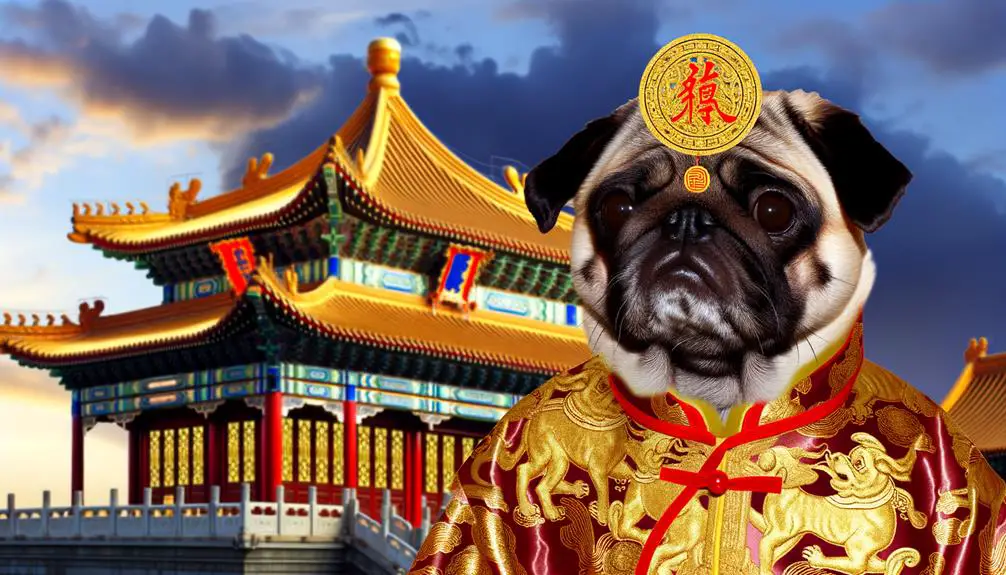
Building upon this tradition of meaningful symbolism, the 'Prince' character found on the foreheads of some pugs represents nobility and good fortune in Chinese culture. This distinctive marking, reminiscent of the Chinese character '王' (Wáng), has been associated with various auspicious qualities. Scientific observations suggest that this unique fur pattern may occur due to genetic variations, yet its cultural implications are profound.
- Nobility: Symbolizes royal status and high social rank.
- Good Fortune: Represents luck and positive outcomes.
- Guardianship: Implies protective qualities and loyalty.
- Historical Reverence: Links to ancient Chinese emperors and their affinity with pugs.
- Aesthetic Appeal: Adds to the visual and symbolic allure of the breed.
Understanding these attributes offers insights into the breed's esteemed status.
Cultural Significance
The cultural significance of the Chinese symbol on a pug's forehead encompasses both historical symbolism and modern interpretations.
Historically, this mark was believed to denote nobility and good fortune, often admired in Chinese art and folklore.
In contemporary contexts, it continues to be celebrated, albeit with varying interpretations that reflect evolving societal values and aesthetics.
Historical Symbolism
Throughout history, the distinctive markings on a Pug's forehead have been imbued with deep cultural significance, particularly in Chinese traditions. These markings, often resembling Chinese characters, have been associated with various symbolic meanings.
The most notable is the 'Three Wrinkle Mark,' which resembles the character for 'prince' (王) in Chinese. This has led to beliefs that Pugs bring good fortune and nobility to their owners.
Additionally, the following points highlight the cultural importance:
- Symbol of Royalty: Associated with the Chinese imperial court.
- Fortune and Prosperity: Believed to attract wealth.
- Longevity: Seen as a symbol of a long life.
- Spiritual Protection: Considered to ward off evil spirits.
- Companionship: Valued as loyal and affectionate pets.
This historical symbolism underscores the Pug's esteemed status in Chinese culture.
Modern Interpretations
In contemporary times, the markings on a Pug's forehead continue to hold cultural significance, often symbolizing good luck and enduring affection in modern societies. This symbolic interpretation has been embraced globally, transcending its origins in ancient Chinese culture.
The unique wrinkles, particularly those resembling Chinese characters, are believed to imbue their owners with positive energy and fortune. This perception is reinforced by modern media and popular culture, which frequently highlight Pugs as charming and endearing pets.
Consequently, the cultural significance of these markings has evolved, intertwining tradition with contemporary aesthetics. Scientific studies on human-animal bonds suggest that such symbolic interpretations enhance emotional connections, reinforcing the Pug's status as a beloved companion animal.
Symbol Variations
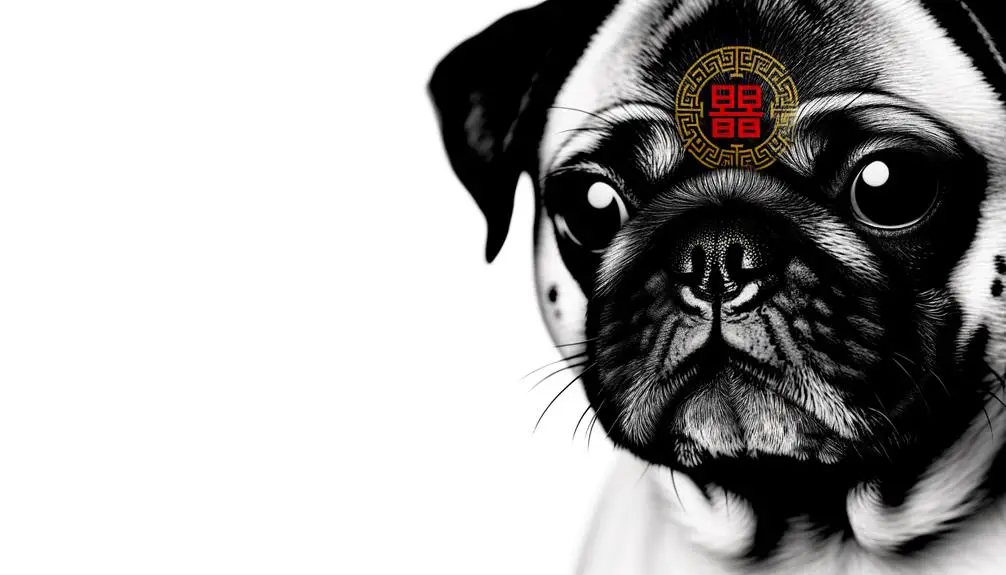
Examining the variations of the Chinese symbol on a pug's forehead reveals a rich tapestry of cultural significance and genetic diversity. These patterns, often resembling Chinese characters such as '王' meaning 'king,' vary significantly among individual pugs. The variations are influenced by a multitude of factors, including genetic lineage, environmental conditions, and selective breeding practices.
Key aspects of symbol variations include:
- Shape and Clarity: Differences in the distinctness and form of the symbol.
- Symmetry: Variability in the symmetrical appearance of the markings.
- Coloration: Range of pigmentation that affects the visibility of the symbol.
- Size: Proportional differences in the symbol's scale relative to the pug's forehead.
- Texture: Variations in fur density and texture influencing the symbol's appearance.
These variations underscore the intricate interplay between genetics and phenotype.
Breeding and Genetics
Understanding the genetic mechanisms behind the distinct Chinese symbol on a pug's forehead requires a thorough exploration of breeding practices and hereditary factors. Selective breeding has been pivotal in accentuating this unique trait, which is believed to be polygenic in nature, involving multiple genes. Breeders often select parent pugs exhibiting prominent symbols to enhance the trait in subsequent generations.
| Genetic Aspect | Description | Impact on Symbol Visibility |
|---|---|---|
| Polygenic Trait | Involves multiple genes | Varies depending on gene interaction |
| Selective Breeding | Choosing parents with desired traits | Increases likelihood of symbol presence |
| Heritability | Degree to which trait is inherited | Determines consistency across generations |
To elucidate these mechanisms, further genetic studies are essential, focusing on the specific loci contributing to this distinctive marking.
Pug Recognition
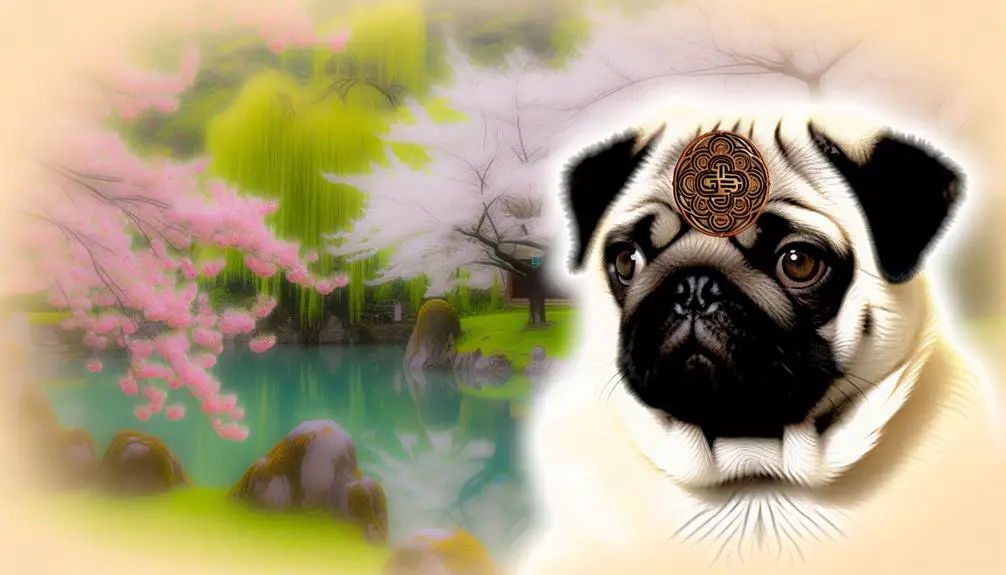
Pug recognition relies heavily on the distinct physical and behavioral characteristics that set this breed apart from others. Their unique attributes facilitate easy identification and include:
- Wrinkled Forehead: Often highlighted by a distinctive pattern resembling a Chinese symbol.
- Compact Build: Pugs possess a sturdy, square body with a well-developed muscle structure.
- Short Muzzle: This brachycephalic trait contributes to their characteristic snorting and breathing sounds.
- Curled Tail: Typically, their tail is tightly curled over the hip.
- Sociable Behavior: Pugs are known for their friendly and affectionate demeanor, often thriving on human interaction.
These traits not only define the breed aesthetically but also contribute to their distinct personality, making them easily recognizable in both domestic and competitive settings.
Popular Myths
Despite the clear physical and behavioral markers that distinguish Pugs, several popular myths about the breed persist. One prevalent myth is that the wrinkles on a Pug's forehead form Chinese symbols, specifically the character for "prince." While these wrinkles are distinct, they do not consistently replicate any specific symbols. Another myth suggests Pugs are inherently lazy, whereas they are, in fact, quite playful and energetic when properly exercised. Lastly, it is often believed that Pugs have chronic respiratory issues due to their short snouts. While brachycephalic breeds are prone to certain conditions, responsible breeding and care can mitigate these risks.
| Myth | Truth | Clarification |
|---|---|---|
| Forehead wrinkles form symbols | Wrinkles do not consistently form symbols | No consistent replication of characters |
| Pugs are lazy | Pugs are playful and energetic | Proper exercise is essential |
| Chronic respiratory issues | Prone to certain conditions, but manageable | Responsible breeding is crucial |
Modern-Day Appreciation

The modern-day appreciation of the pug's forehead symbol encompasses both its cultural significance and its influence on contemporary fashion and trends.
Today, this unique marking is often celebrated in popular media, art, and clothing, reflecting a broader recognition of its heritage.
Such trends highlight the ongoing integration of traditional symbolism into modern aesthetics.
Cultural Symbolism Today
In contemporary society, the Chinese symbol on the forehead of pugs is increasingly recognized as a unique blend of cultural heritage and modern-day aesthetics. This distinctive marking is not merely a physical trait but carries significant symbolic meaning that resonates with various cultural dimensions.
- Historical Significance: The symbol is historically linked to Chinese royalty and nobility.
- Cultural Identity: It serves as a representation of Chinese cultural identity and tradition.
- Artistic Expression: Modern appreciation often views it as a form of natural artistry.
- Symbol of Luck: Many consider the marking a symbol of good fortune and prosperity.
- Cultural Preservation: It aids in the preservation and recognition of ancient cultural practices.
Understanding these aspects enriches the appreciation of this unique characteristic.
Fashion and Trends
Modern fashion and aesthetic trends have increasingly embraced the Chinese symbol on the forehead of pugs, viewing it as a unique and culturally rich feature that adds depth to contemporary style narratives. This distinctive mark, often resembling the Chinese character for 'prince' (王), has been incorporated into various fashion elements, from apparel to accessories.
Designers are leveraging this symbol to create products that resonate with both cultural appreciation and modern aesthetics. The trend underscores a growing appreciation for cultural diversity and heritage in fashion. This convergence of traditional symbolism and contemporary design reflects a broader movement towards inclusivity and global interconnectedness in the fashion industry, aiming to educate and inspire consumers through culturally meaningful elements.
Conclusion
The historical and cultural significance of the pug's forehead markings, often likened to the ancient Chinese 'Prince' character, underscores the breed's esteemed status and symbolic heritage. Variations in these markings highlight the complexities of breeding and genetics.
How has this small canine come to embody such rich tradition and myth? Modern appreciation continues to celebrate the pug's distinctive appearance and storied past, ensuring its place in both historical study and contemporary admiration.


